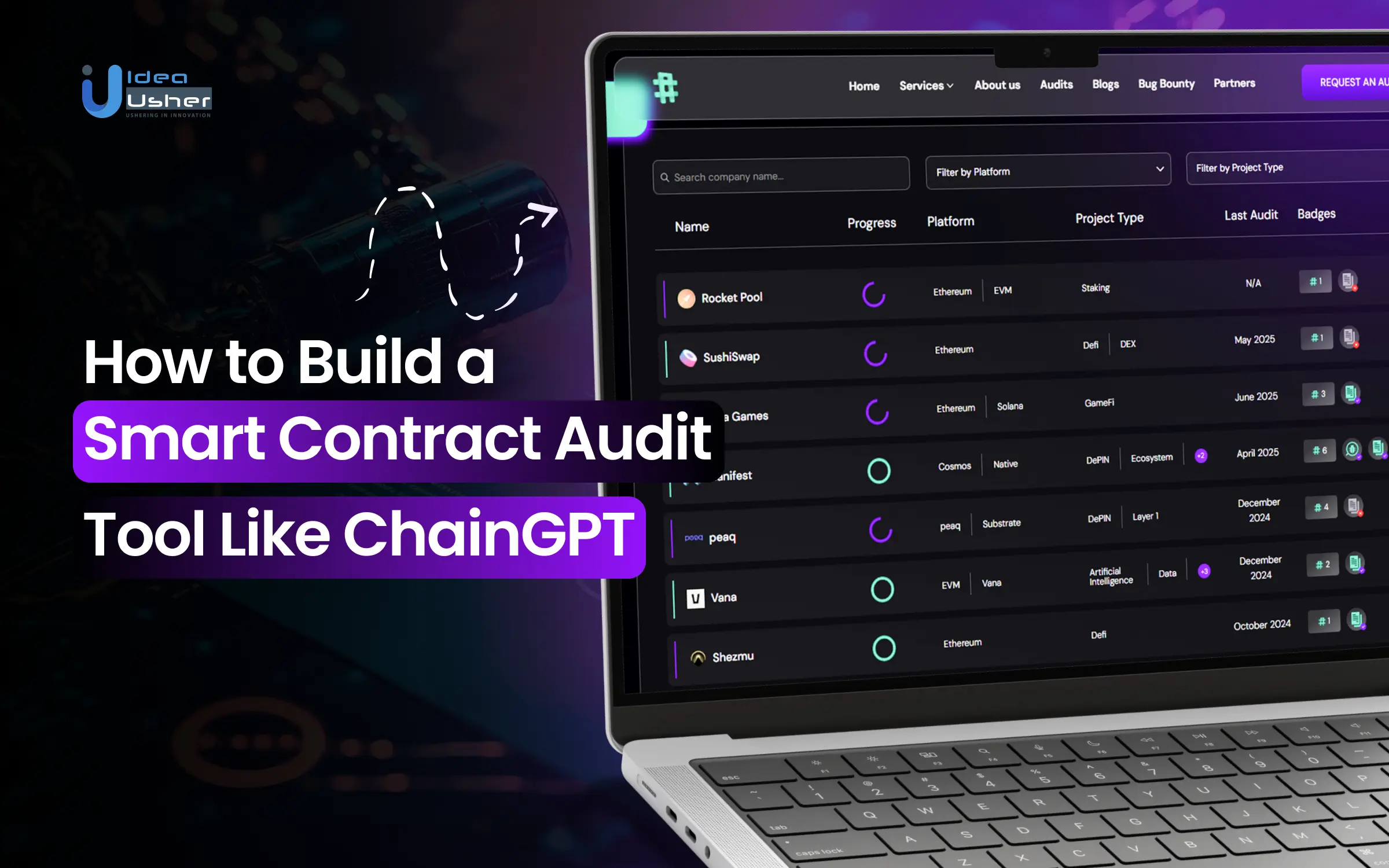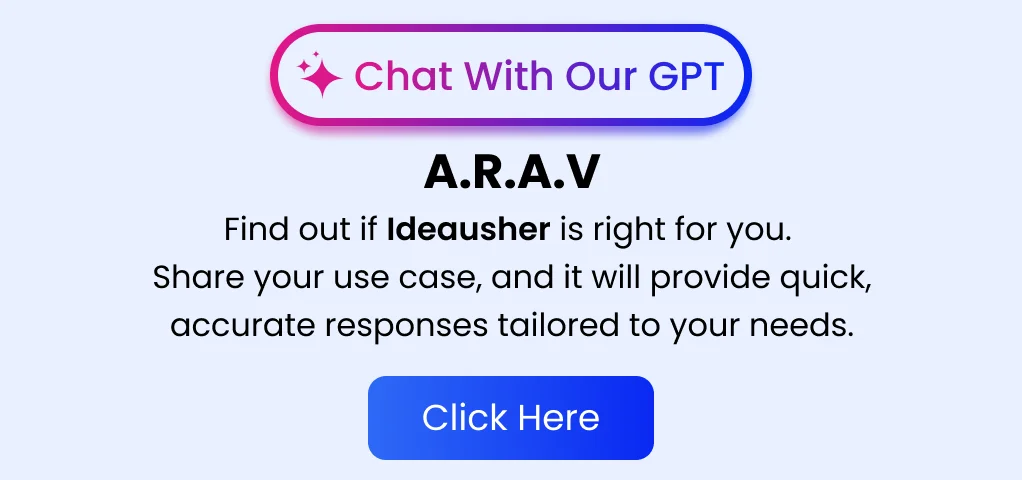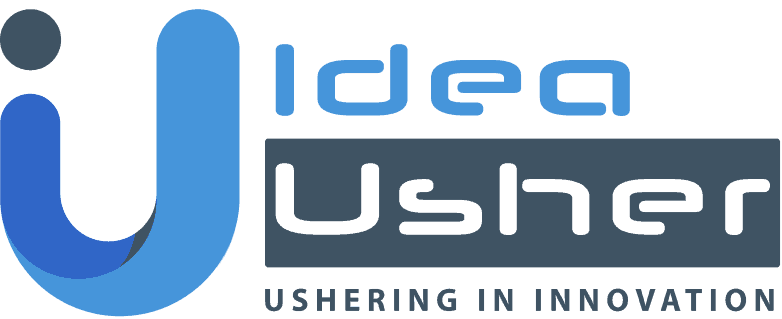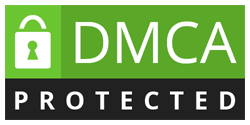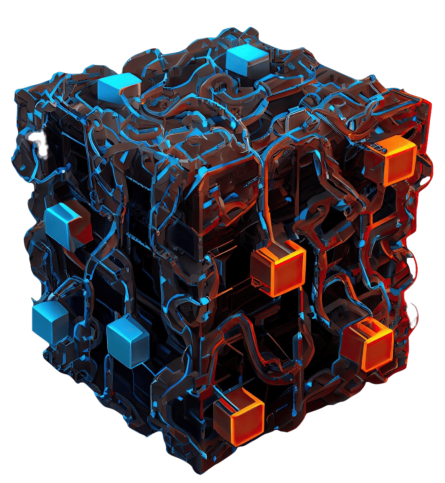Smart contracts are transforming how digital agreements are created, executed, and verified across industries. But as their adoption increases, so does the risk of vulnerabilities and coding flaws that can lead to security breaches or financial loss. To ensure trust and safety, automated auditing tools powered by AI are becoming essential. Platforms like ChainGPT have made it easier to scan smart contracts quickly and detect issues that could be missed in manual reviews.
In this blog, we will talk about how to build a smart contract audit tool like ChainGPT. You will learn about the core architecture, essential features, and AI models involved in automating the audit process. We will also walk through the development steps, compliance needs, and integration capabilities required to create a secure and scalable solution. As we have helped various enterprises launch their blockchain and AI products across regulated industries, IdeaUsher has the expertise to guide you through building a reliable, intelligent audit tool tailored for Web3 applications.

What is ChainGPT?
ChainGPT is an AI-powered platform designed specifically for the Web3 and blockchain ecosystem. It offers tools such as a smart contract generator (built on a proprietary “Solidity LLM”) and an AI-powered auditor that detects vulnerabilities, logic errors, and gas inefficiencies in Solidity code via REST API and SDK. Supporting cross-chain deployments across EVM networks, ChainGPT democratizes smart contract creation and auditing with rapid, security-first automation.
Key Use Cases
Before building a smart contract audit tool like ChainGPT, it’s important to understand the full scope of use cases such a platform can serve. These go beyond simple auditing and extend into code generation, community support, and blockchain research.
- Contract auditing: Enables real-time smart contract security scanning through API or SDK integration. It identifies logic flaws, gas inefficiencies, reentrancy issues, and compliance violations, delivering human-readable reports along with actionable remediation steps.
- Code explanation and generation: Allows users to generate complete smart contract code from text-based prompts and provides plain-English explanations of code logic, helping developers iterate faster and onboard non-technical users.
- Vulnerability detection: Uses a hybrid of AI and static analysis to detect deep-layer flaws like integer overflows, poor access control, and faulty contract logic. This results in a more thorough audit compared to traditional tools.
- Web3 AI chatbots and support desks: Deploys intelligent, multilingual bots across platforms like Discord, Telegram, or custom apps to handle questions on tokenomics, NFTs, DeFi mechanics, and other blockchain interactions, reducing the load on community managers.
- AI research and analytics assistants: Automates tasks such as summarizing whitepapers, tracking token metrics, generating live dashboards, and curating blockchain-related news content. Ideal for analytics platforms, investor portals, and crypto content hubs.
How ChainGPT Combines AI and Blockchain Security?
Security in blockchain development goes beyond basic audits. ChainGPT combines AI analysis with secure coding practices, cross-chain support, and full development lifecycle integration to ensure smart contracts are not just functional but production-grade and verifiable.
1. AI-Powered Smart Contract Auditing
ChainGPT uses a Web3-specialized LLM to scan Solidity code via API or SDK, detecting critical issues like reentrancy, overflow, access control gaps, and gas inefficiencies. It evaluates ERC compliance, logic flaws, and assigns severity scores, delivering audit-grade results within minutes.
2. Security-Driven Optimization
Instead of just flagging bugs, ChainGPT also recommends gas-saving improvements like optimizing loops or removing redundant steps. It checks adherence to ERC‑20, ERC‑721, and ERC‑4626 standards while detecting weak permission logic or missing defensive patterns, ensuring cleaner and safer code.
3. Development Pipeline Integration for Prevention
ChainGPT can be integrated into CI/CD workflows such as GitHub Actions. Every code push or pull request triggers automated audits. High-severity findings can block deployment, helping developers catch vulnerabilities early and enforce security from the first commit.
4. Cross-Chain and Multiplatform Support
ChainGPT supports auditing on multiple EVM chains like Ethereum, Arbitrum, Avalanche, and BNB Chain, with beta features for non-EVM blockchains. This ensures consistent risk scanning, whether your contracts are deployed on testnets or live across different ecosystems.
5. Accountability Through Transparency and Trust Scores
Each audit includes a security score (0 – 100%), along with clear remediation suggestions and severity breakdowns. These reports can be shared with stakeholders, converted into PDFs, or tied to DAO-based governance, helping enforce transparency in smart contract deployments.
6. Synergy of Blockchain Immutability and AI Assurance
Audit results can be stored on-chain or verified through governance mechanisms, preserving the record immutably. This blend of AI-audited outputs with blockchain transparency ensures tamper-proof logs, enabling audit trails that are verifiable, decentralized, and secure for long-term trust.
Why You Should Invest in Launching a Smart Contract Audit Tool?
The smart contracts market was USD 2.02 billion in 2024 and is projected to grow from USD 3.69 billion in 2025 to about USD 815.86 billion by 2034, at an 82.21% CAGR. This growth is driven by increased DeFi adoption, tokenized assets, and complex on-chain applications requiring security audits.
ChainGPT, a platform combining AI with blockchain audit tools, has raised $4.2 million in funding to scale its smart contract automation and AI-driven auditing technology, reflecting strong investor confidence in the intersection of blockchain and artificial intelligence.
CertiK, a leading name in blockchain security, has secured over $80 million in funding. The platform offers advanced formal verification, AI monitoring, and real-time audit capabilities trusted by major exchanges and DeFi protocols.
Quantstamp, another key player in decentralized application auditing, has raised $25 million. Their hybrid approach of automated audits with human verification caters to a wide range of enterprise and DeFi projects.
The smart contract audit landscape is becoming essential in Web3. With regulatory pressures, hacks, and institutional interest, launching an AI audit tool fills a vital need and positions you at the forefront of blockchain security. Combining automated AI, scalable revenue, and multi-chain support makes this space highly investable and future-proof.
How Smart Contract Auditors Help Prevent Blockchain Exploits?
Even the most promising blockchain projects are vulnerable if their smart contracts are not secure. A powerful smart contract audit tool can protect your protocol from costly exploits, improve trust, and ensure safe interactions across decentralized ecosystems.
1. Identify Critical Vulnerabilities Before Deployment
Using tools like ChainGPT AI audit systems, developers can detect serious issues such as reentrancy bugs, access misconfigurations, logic errors, and integer overflows. These vulnerabilities, if missed, can lead to large-scale fund theft, as seen in DAO and Ronin hacks.
2. Simulate Attack Vectors and Edge-Case Behavior
Modern smart contract auditing includes dynamic techniques like fuzzing, symbolic execution, and real-time attack simulations. These processes mimic edge-case scenarios to uncover hidden risks such as oracle manipulation, improper state changes, or unexpected denial-of-service vulnerabilities.
3. Validate Logic Against Stakeholder Intentions
Security is not just about code quality but also about ensuring the contract behaves as intended. Audit teams validate that the smart contract logic aligns with business goals, checking things like token supply limits, vesting logic, or DAO governance mechanisms.
4. Align with Industry Security Standards & Best Practices
Smart contract auditors follow established frameworks like the SWC Registry and OWASP. By applying secure design patterns such as checks-effects-interactions or RBAC, a smart contract audit tool helps projects minimize both known and hidden threats across blockchain ecosystems.
5. Safe Remediation & Optimize Efficiency
A strong audit process includes more than just pointing out flaws. Expert auditors provide actionable fixes, code refactoring tips, and gas optimization suggestions ensuring your contract is both secure and resource-efficient before going live on the blockchain.
6. Provide Transparent, Trust-Building Audit Reports
The final step in smart contract auditing is the delivery of detailed and transparent reports. These documents include vulnerability ratings, mitigation steps, and verification status. Public audit reports boost investor confidence and make exchange listings or DAO participation more likely.
Role of AI in Smart Contract Audit Tool
Before we explore the development process, it’s important to understand how AI significantly enhances the performance of smart contract auditing tools. From vulnerability detection to remediation guidance, these intelligent systems are streamlining audit workflows and reducing risks across blockchain ecosystems.
1. Automated Static & Dynamic Code Analysis
AI audit engines combine machine learning with symbolic execution to inspect smart contract logic. This approach flags logic flaws, gas inefficiencies, reentrancy vulnerabilities, and unchecked calls with higher accuracy. Unlike traditional analyzers, AI overlays contextual insights to ensure deeper and broader smart contract auditing coverage.
2. Proactive Real-Time Vulnerability Detection
AI systems integrated into IDEs or CI/CD pipelines detect issues such as integer overflows and access-control errors as developers write code. This real-time detection capability reduces feedback loops and accelerates the delivery of secure contracts, making ChainGPT AI audit tools highly valuable in rapid development environments.
3. NLP-Driven Contract Interpretation and Documentation
Natural Language Processing is used to extract intent from comments, specs, and documentation. This helps align contract behavior with the expected logic, enabling discrepancy detection, stakeholder-friendly explanations, and clear documentation for regulatory or investor audits in smart contract audit tools.
4. Pattern & Predictive Analytics on Vulnerability Trends
By training on previous exploits and audit reports, AI learns to recognize patterns in emerging vulnerabilities. This allows auditors to anticipate flaws that might escape traditional reviews. It strengthens the reliability of modern smart contract auditing platforms used in DeFi and DAO ecosystems.
5. Continuous Monitoring & Post-Deployment Alerting
AI engines can track deployed contracts and monitor them for anomalies such as protocol drift, unauthorized function calls, or suspicious activity. This real-time monitoring helps detect threats early, reducing the risk of major losses and adding post-deployment value to smart contract audit tools.
6. Cost-Effective Scalability & Efficiency
By automating repetitive tasks like code scanning and basic analysis, AI tools make auditing faster and more affordable for startups and smaller Web3 projects. This ensures that even low-budget DeFi/NFT ventures can benefit from high-quality smart contract auditing without compromise.
7. Explainable Remediation Guidance
AI systems go beyond identifying flaws by offering code suggestions, refactoring tips, and gas-saving alternatives. This bridges the gap between raw vulnerability detection and actual fixes, making tools like ChainGPT AI audit platforms more actionable for developers and security teams.
Key Features to Include in a Smart Contract Audit Tool
Before building a smart contract auditing platform like ChainGPT, it’s essential to define the key features that make the tool both developer-friendly and security-focused. Each feature must address real pain points in smart contract auditing while supporting automation, speed, and cross-chain compatibility.
1. AI-Powered Static & Dynamic Code Analysis
A smart contract audit tool must deeply scan both the code’s structure and how it behaves when deployed. Using ChainGPT AI audit-style models, it can detect reentrancy attacks, logic flaws, or improper input handling by analyzing control flow, syntax, and execution. Runtime simulations further expose edge-case vulnerabilities that only occur under specific network conditions.
2. Real-Time Vulnerability Detection
Instead of waiting for full audits, the system should instantly alert developers to serious risks like access control bugs or gas-heavy functions as they code. This real-time detection is made possible by AI layered over traditional CVE pattern matching, mirroring how smart contract auditing should shift from reactive to proactive.
3. Contract Explanation in Plain Language
AI should be able to summarize what each function in a smart contract actually does using clear language. This makes the smart contract audit tool understandable even to DAOs or non-technical investors, promoting audit transparency and more inclusive governance decisions across DeFi projects.
4. Audit Score or Risk Grading System
Post-audit, the platform must assign a visible risk score, allowing teams to compare their contract’s security level with industry benchmarks. A ChainGPT-like audit system, color-coded or percentile-based, helps in conveying severity and likelihood of exploits, thus aiding decision-makers and third-party auditors.
5. Tokenomics and Logic Validation
A contract might be secure but still unfair in its token economics. AI should validate rules around minting, vesting, burning, and treasury movement to prevent governance abuse. This logic-layer audit ensures smart contract auditing extends beyond syntax and includes token fairness and launch integrity.
6. Version Control & Code Comparison
Smart contract vulnerabilities are often introduced during upgrades. The audit tool should allow developers to compare two contract versions, highlighting changed logic, functions, or permissions. This change tracking is crucial for teams pushing updates on forked DeFi protocols or long-term DAO projects.
7. Multi-Chain Support
With Web3 expanding across ecosystems, the tool must audit contracts on Ethereum, BNB Chain, Solana, Arbitrum, and more. AI audit models can be adapted for EVM bytecode, Rust contracts, or Vyper scripts ensuring consistent risk analysis across the growing landscape of dApps.
8. Audit Report Generation
After the audit, the tool should output reports in JSON or PDF, formatted for compliance reviews or public trust. These reports should detail CVEs, reproduction paths, and fixes, so teams can remediate quickly while also using them for exchange listings or funding rounds.
9. API Access for Developer Tools
APIs are a must-have for modern development workflows. The smart contract audit tool should integrate with GitHub Actions, Jenkins, or Remix IDEs, allowing automated audits to run with every pull request or contract deployment. This makes security a default part of CI/CD operations.
10. AI Chat Support for Smart Contract Queries
Non-tech users often need help understanding audit results or contract logic. In-app AI chat assistants can break down function behavior, flag best practices, or explain why a piece of code is risky. This aligns with ChainGPT’s vision of making smart contract auditing both accessible and educational.

Development Process of an AI Smart Contract Audit Tool like ChainGPT
Building a powerful audit platform is not just about running code checks. It’s about designing a scalable, developer-friendly system that evolves with Web3 threats and developer needs. Here’s how our blockchain developers at IdeaUsher approach building an advanced smart contract audit tool with AI integration and multi-chain support.
1. Consultation
Our process begins with a deep consultation to understand your smart contract ecosystem, business model, and security priorities. We define whether the smart contract audit tool will focus on DeFi protocols, NFT platforms, DAO governance, or general dApps. This ensures the solution’s audit coverage and AI models are tailored precisely to your target users and contract vulnerabilities.
2. Select Supported Chains and Contract Standards
We carefully decide which chains the audit tool should support whether Ethereum, BNB Chain, Polygon, or Solana. Our team maps out the technical requirements for Solidity, Vyper, and Rust, and ensures compatibility with standards like ERC-20, ERC-721, and ERC-1155 to cover NFT, token, and DeFi use cases effectively across ecosystems.
3. Plan AI Integration for Code Interpretation
We define the AI model’s role from day one. Our developers choose between fine-tuned LLMs and pre-trained models like GPT-4 to automate bug prioritization, code explanation, and suggestion generation. This reduces audit turnaround time and allows us to offer features like AI contract explanation and risk score grading for developers and non-technical users alike.
4. Build the Static Analysis Engine
We build a deep static analysis layer that parses code without execution. Our team uses control flow graphs, syntax trees, and symbolic execution to detect flaws like access control issues, logic errors, and unvalidated input handling. This engine acts as the core of the tool’s vulnerability detection system and supports all audit automation layers.
5. Develop the Audit Dashboard and Reporting System
Our UI/UX and backend teams collaborate to create a clean, insight-rich audit dashboard. Users can view vulnerabilities, compare contract versions, and download audit reports in PDF or JSON. CI/CD hooks, project history logs, and severity rankings are built-in, making it useful for security teams, DeFi startups, and enterprise users managing multiple dApps.
6. Train the NLP Model on Solidity, Vyper, etc.
We fine-tune AI models on real smart contract datasets, audit documents, and security reports. This training focuses on languages like Solidity, Vyper, and Rust, so the AI can generate accurate explanations or remediation advice. It’s the foundation of features like AI chatbot assistance and contract-to-English translation within the audit tool.
7. Test with Known Vulnerabilities
We deploy smart contracts from the SWC registry, which contains documented weaknesses like reentrancy, denial-of-service, and logic bugs. Our team verifies the tool’s accuracy against these known threats, providing you with measurable audit performance and building confidence in the tool’s ability to catch real-world vulnerabilities early in development.
8. Deployment and Ongoing Model Updates
We deploy the tool on secure cloud infrastructure, set up API access for developer tools like GitHub Actions or IDEs, and integrate CI/CD for auto-auditing. Post-launch, our engineers monitor real usage data, collect feedback, and retrain AI models regularly to adapt to evolving Web3 exploit patterns and improve detection quality.
Cost to Develop an AI Smart Contract Audit Tool like ChainGPT
Building a smart contract audit tool like ChainGPT involves complex AI and blockchain integrations, which directly impact the overall cost. Below is a detailed cost breakdown to help you understand how your budget aligns with each development phase.
| Development Phase | Estimated Cost | Description |
| Consultation | $5,000 – $8,000 | Understanding your business goals, audit coverage, and compliance targets |
| Blockchain & Standards Setup | $15,000 – $22,000 | Supporting EVM/non-EVM chains, token standards, and contract formats |
| AI Model Planning & Integration | $25,000 – $40,000 | Integrating and fine-tuning Codex/GPT-4 or custom LLMs for smart contract auditing |
| Static Analysis Engine Development | $30,000 – $45,000 | Building symbolic execution, bytecode analyzers, and logic flaw detectors |
| Audit Dashboard | $18,000 – $25,000 | UI/UX with audit results, severity reports, exports, and historical tracking |
| NLP Model Training | $20,000 – $28,000 | Training domain-specific models for contract explanation and bug reporting |
| Testing with SWC Registry Cases | $8,000 – $12,000 | Simulating exploits to test detection coverage and reliability |
| Deployment | $15,000 – $22,000 | CI/CD support, cloud infra, secure API setup for GitHub or IDE integration |
Total Estimated Cost: $80,000 – $140,000
Note: The final cost varies by feature complexity, supported chains, AI model customization, and infrastructure needs. Projects mimicking a smart contract audit tool like ChainGPT AI audit will need a bigger budget for enterprise-scale scalability and accuracy.
Consult with IdeaUsher’s experts to get a tailored quote and development roadmap based on your specific audit goals and feature set. Our team will help you align technical decisions with your business model for maximum ROI.
Technology Stack Required for an AI-powered Smart Contract Audit Tool
To build a smart contract audit tool like ChainGPT, you’ll need a stack that brings together AI, secure code analysis, and blockchain compatibility. Below is a breakdown of the technologies that work together to power a robust, scalable auditing platform.
1. AI/NLP Models
These models help the system understand smart contract code, detect patterns, and explain complex logic in simple terms. They form the intelligence layer of your tool.
- GPT-4 or GPT-4 Turbo: Enables the tool to generate clear, contextual audit summaries and explain vulnerabilities in human-readable language.
- Codex (OpenAI): Tailored for programming tasks, this model can interpret Solidity code and assist in detecting logic flaws or suggesting improvements.
- BERT (fine-tuned on Solidity contracts): Helps classify contract segments, extract meaning from code snippets, and improve the accuracy of vulnerability detection.
2. Audit Engines
These engines scan the code to identify potential vulnerabilities. They serve as the core scanning mechanism of your audit tool.
- Slither: A powerful static analysis framework for Solidity, ideal for catching known issues quickly before deployment.
- Mythril: Performs symbolic execution, which simulates different contract states to uncover bugs like reentrancy and integer overflows.
- Oyente: One of the earlier tools for analyzing Ethereum smart contracts, still useful for catching logic errors and common exploits.
- Manticore: A dynamic analysis tool that executes smart contracts across various input combinations to test complex logic paths.
3. Blockchain Integration
You’ll need libraries that allow your tool to connect with blockchain networks and access contract data. These libraries make it possible to analyze both deployed and testnet contracts.
- Web3.js: A widely used JavaScript library for interacting with Ethereum, suitable for backend operations like contract fetch and bytecode parsing.
- Ethers.js: A more lightweight alternative to Web3.js, often preferred for frontend integrations due to its modular design and better developer experience.
- Solana Web3.js: Enables access to Solana-based smart contracts, which is essential if your audit tool supports multiple chains beyond Ethereum.
4. Frontend Technologies
The user interface should be clean, fast, and built with developers in mind. These tools help create intuitive dashboards and interactive audit experiences.
- React.js with Tailwind CSS; React powers dynamic interfaces, while Tailwind ensures fast styling with a utility-first approach for custom design flexibility.
- Next.js: Useful for server-side rendering and faster load times, especially if you’re targeting enterprise clients or want to improve SEO performance.
5. Backend Technologies
Your backend connects the frontend, audit engines, and AI services. This is where most of your logic processing and orchestration will happen.
- Node.js: Manages asynchronous API requests and efficiently handles audit task queuing and result delivery.
- Python + FastAPI: Ideal for integrating Python-based audit tools and running backend scripts that trigger vulnerability scans or interact with LLMs.
6. DevOps and Deployment
A stable deployment environment ensures that your tool is secure, performs well under load, and is easy to update or scale.
- AWS or GCP: Reliable cloud platforms that offer flexibility for compute-intensive tasks like AI inference and contract scanning.
- Docker: Lets you package audit engines, models, and services into containers for consistent deployment and easier debugging.
- Kubernetes: Automates deployment, scaling, and load-balancing for your microservices, especially useful when handling multiple audits simultaneously.
7. Database and Storage
To store audit results, user data, and contract metadata securely, you’ll need both structured databases and optional decentralized storage.
- PostgreSQL: A trusted relational database for storing detailed audit logs, user accounts, and contract metadata.
- IPFS: Allows for decentralized and tamper-proof storage of audit reports, ensuring transparency and data integrity.
- Firebase: Offers an easy-to-use backend service for managing authentication, real-time updates, and quick data retrieval during MVP stages.
How to Mitigate Challenges of Developing a Smart Contract Audit Tool?
As you build an AI-powered smart contract audit tool like ChainGPT, there are a few unavoidable hurdles that need strategic attention. These challenges not only affect performance but also influence trust, accuracy, and product-market fit in the competitive blockchain ecosystem.
1. Smart Contract Complexity and AI Limitations
Challenge: Many smart contracts today are highly modular, complex, or built using evolving frameworks like proxy patterns or upgradable architectures. AI models may struggle to interpret hidden dependencies or dynamic execution paths, resulting in overlooked vulnerabilities or false positives.
Solution: To solve this, we train AI models on a wider range of contract types, including modular and upgradable architectures. We also pair static AI analysis with runtime simulations to detect logic gaps, making the tool better equipped for real-world audit scenarios.
2. Keeping Audit Models Updated with New Vulnerabilities
Challenge: Attack vectors evolve quickly in the Web3 space. Without regular updates, AI models may fail to detect new vulnerabilities, especially in emerging contract patterns like zk-rollups or MEV-resistant architectures.
Solution: We integrate a continuous learning framework into the tool, feeding in datasets from recent exploits, public audit reports, and threat intelligence. This ensures the AI system stays current and adaptive, capable of flagging even newly discovered vulnerability patterns in smart contract auditing.
3. User Mistrust in Automated Tools
Challenge: Some developers and projects are skeptical about AI-generated audit results. They worry about false positives, incomplete findings, or lack of transparency in how conclusions are drawn, which can slow down adoption.
Solution: We address this with explainable AI techniques that present each issue along with context, suggested fixes, and confidence scores. This makes audits not only transparent but also more actionable and easier to trust by non-AI-savvy teams.
4. Multi-Chain Compatibility Issues
Challenge: With dApps launching across EVM and non-EVM chains, many AI audit tools fail to support diverse smart contract languages or network-specific behavior, limiting the tool’s usability for multi-chain projects.
Solution: We solve this by building modular parsing engines and AI models trained on Solidity, Vyper, Rust, and Move, enabling the audit tool to support chains like Ethereum, Solana, Aptos, and more from a single dashboard.
Conclusion
Building a smart contract audit tool like ChainGPT requires a thoughtful blend of blockchain knowledge, AI capabilities, and cybersecurity expertise. As smart contracts continue to power critical transactions, ensuring their accuracy and safety has become a top priority. From automating vulnerability detection to streamlining audit workflows, these tools offer real value to developers and organizations alike. By focusing on precision, scalability, and regulatory alignment, you can develop a solution that not only identifies risks but also builds confidence across blockchain ecosystems. A well-built audit tool can serve as both a shield and a standard for smart contract integrity.
Why Choose IdeaUsher to Build Your Smart Contract Audit Tool?
IdeaUsher has extensive experience in developing AI-powered blockchain tools that ensure smart contracts are secure, verifiable, and audit-ready. Our focus lies in building platforms that integrate advanced static and dynamic analysis, LLM integration, and real-time vulnerability detection engines.
Why Work with Us?
- Blockchain and AI Synergy: We combine deep expertise in smart contract logic with large language models to identify risks effectively.
- Custom Development: From building rule-based auditing engines to integrating token-gated dashboards, our solutions are tailored to your vision.
- Proven Track Record: We’ve developed and deployed platforms like EQL, SALVAcoin, and Veelive that meet strict security and data integrity standards.
- Scalable and Compliant: Our systems are designed to evolve with blockchain protocols while meeting privacy and compliance benchmarks.
Explore our portfolio to see how we’ve delivered blockchain solutions that prioritize security, scalability, and precision within highly regulated digital environments.
Let us help you build an intelligent audit platform that adds credibility, automation, and transparency to your smart contract ecosystem.
Work with Ex-MAANG developers to build next-gen apps schedule your consultation now
FAQs
A smart contract audit tool like ChainGPT scans blockchain-based code to identify bugs, vulnerabilities, and logic errors. It uses static and dynamic analysis techniques along with AI models to flag security issues before contracts are deployed.
You need Solidity parsers, static analysis engines, AI language models for logic validation, and smart contract simulators. Blockchain integration, threat databases, and real-time reporting modules are also essential to deliver accurate and actionable audit insights.
AI enhances smart contract auditing by understanding code context, predicting attack patterns, and learning from past exploits. It can automatically detect complex logical flaws and recommend fixes faster than manual review alone, improving accuracy and efficiency.
Yes, an audit tool can be built to support specific chains like Ethereum, BNB Chain, or Solana. By integrating chain-specific rules and execution environments, the tool can provide more precise analysis tailored to each network’s smart contract logic.
